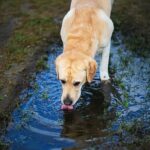When a Dog Becomes Infected

Dogs become infected by leptospires when abraded (irritated or cut) skin comes into contact with infected urine or with water contaminated with infected urine. Alternatively, bite wounds, exposure to reproductive secretions, and even consumption of infected tissues can transmit this infection. The organisms quickly spread through the bloodstream leading to fever, joint pain, and general malaise. The organism distributes to multiple organs and wreaks havoc. Which organs are most affected depends on the serovar of the organism, the immunity of the dog, and the age of the dog. The organism settles in the kidneys and begins to reproduce, leading to further inflammation and then kidney failure in 90 percent of patients (10-20% also have liver failure).
Leptospirosis (also called Lepto for short) can be an acute disaster of severe illness but most dogs survive their acute phase and are not diagnosed until they reach a more chronic stage. For example, the most common manifestation of leptospirosis-related kidney failure is excessive water consumption a week or two after an episode of unexplained fever.
Typical Symptoms and Clinical Picture
- Fever, depression, loss of appetite, joint pain, nausea, excessive drinking, jaundice, excess bleeding brought on by low platelet count.
- Recovered animals can shed leptospires for months after recovery. Younger animals tend to be more severely affected than older animals.
- Most cases are diagnosed between July and December and involve large breed dogs in rural or suburban environments.
- There may be a genetic predisposition for infection in German Shepherd dogs.
About the Organism
Leptospira organisms are spiral-shaped bacteria called spirochetes. There are several species of leptospires, but the ones that cause disease have been grouped into one particular species called Leptospira interrogans sensu lato. From here, Leptospira interrogates sensu lato has been sub-classified into smaller related groups called SEROVARS. Over 250 serovars have been been named and at least 10 are important for pets. Vaccine for dogs, however, exists against only four serovars. Different serovars produce different types of disease and are in different geographical areas.
Humans can be infected with Leptospira interrogates sensu lato as well (see below). Leptospires are transmitted either directly, meaning through direct contact with infected tissue or secretions, or indirectly, meaning through contact with contaminated water, soil or food. The most common means of transmission is by urine-contaminated water. Leptospire organisms are able to survive for months in cool moist earth, assuming they do not actually freeze or become exposed to direct sunlight. Once they are in the soil, they readily wash into bodies of water, including puddles. Urine contamination usually comes from wildlife (especially rats and raccoons) but could come from infected dogs.
Testing
Leptospire organisms are difficult to detect; it turns out to be much more practical to look for antibodies made against the organisms with the idea being that if antibodies are present, so is the organism. The problem with this idea is that many dogs are vaccinated against leptospirosis, which means that they will have antibodies without infection. Vaccination status must be considered when antibody levels are tested.
Antibody levels are expressed as titers, which are ratios reflecting how much dilution of the sample is needed before it is too dilute to detect antibodies. For example, a titer of 1:32 means the serum diluted out 32 times still had detectable antibody. A titer of 1:32 may sound pretty high but it is actually pretty low; an MAT titer must be at least 1:800 to be considered positive.
MAT Testing
The traditional blood test to detect antibodies against Leptospira interrogans sensu lato is the MAT test, which stands for microscopic agglutination testing. While a value of 1:800 or higher is supportive of a positive diagnosis, confirmation is not made until a second titer is run between 2 and 4 weeks and shows a four-fold increase. Vaccination may interfere with testing since obviously the entire point of vaccinating is to generate antibodies. If the dog has been vaccinated in the last 3 months, testing will be difficult to interpret; however, a single titer of 1:800 or higher against a serovar for which there is no vaccine is considered a positive result. Paired titers may not be practical as one may not want to wait 2 to 4 weeks to begin therapy so some judgment is necessary to consider the patient’s status versus how high the initial titer is and the patient’s vaccination status.
ELISA Testing
Recently test kits for in-clinic use have become available and these are helpful in determining whether a titer is high from vaccination or from natural disease. It turns out that fresh infections produce a specific type of antibody called IgM, and an ELISA test is able to determine if a titer is high in the IgM category or in the more long-term IgG category. A high IgM titer indicates a new and active immune stimulation and, unless the dog was recently vaccinated, implies active infection.
Other Tests
The PCR test, which detects even small amounts of leptospire DNA, is an excellent test if vaccination has been recent. PCR testing is becoming more common and may supplant the MAT test as a confirming test. The problem is that it will detect dead organisms, which can make it hard to interpret in a recovering patient.
Urine may be submitted for what is called Darkfield microscopy. In this test, a dark background may offset the paler leptospire organisms rendering them visible. This sounds like a good way to make the diagnosis but the problems are:
- The urine sample must be fresh and most animal hospitals do not have the capability to do dark field microscopy.
- Leptospires are only shed in urine intermittently. The kidney may be biopsied and tissue stains may be used to detect leptospire organisms. Obviously this is an invasive procedure.
Treatment
Fortunately, Leptospira interrogans sensu lato is sensitive to penicillin, a readily available antibiotic. After penicillin has been used to stop leptospire reproduction and limit bloodstream infection, tetracycline derivatives (such as doxycycline) are used to clear leptospires from the kidneys. Leptospires are cleared from the blood within 24 hours of starting antibiotic treatment but it takes about a week for them to clear from the urine so it is important to wear gloves, goggles, etc. and be conscious of contamination.
Intravenous fluids are crucial to support blood flow through the damaged kidneys so that recovery is possible. Any areas at home that have been contaminated with urine should be disinfected with an iodine-based product and gloves should be warn while cleaning up any urine. Prognosis is guarded depending on the extent of organ damage with appropriate treatment 80-90 percent survival rates are reported.
Prevention
Vaccination Options
Prevention against Leptospira interrogans sensu lato is only available for the serovars called canicola, grippotyphosa, pomona and icterohaemorragiae. (Some vaccines cover all four serovars while others cover only two out of four.) As a result of long standing use of this vaccine, it is hard to assess how important it is to vaccinate against leptospirosis. (As you might imagine, most recent outbreaks involve serovars for which vaccination does not exist,which suggests that the vaccine is working.)
Vaccination against canicola and icterohaemorragiae has been traditional for dogs as it is included in the basic distemper shot (DHLPP – the “L” stands for leptospirosis). The American Animal Hospital Association vaccine guidelines consider vaccination against leptospirosis to be optional but recommends that if one is going to vaccinate for leptospirosis, one should use a vaccine covering all four serovars.
In the past, leptospirosis vaccine was felt to be associated with a higher chance of immunological vaccine reactions,but vaccines made from leptospires grown in protein-free media have made vaccination reaction far less likely. A recent study involving thousands of dogs and their vaccinations showed no increase in vaccine reaction risk with leptospirosis vaccination.
Other important aspects of prevention include controlling rodents in the pet’s environment and removing standing water.
The Infection in Humans
As the Centers for Disease Control and Prevention monitor leptospirosis cases in people, it seems that one third come from contact with infected dogs and one third come from contact with rats (usually through field work). Similar symptoms occur in humans as would be seen in dogs.


